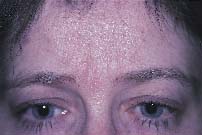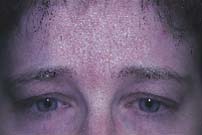Botulinum toxin: effective for both cosmetic, ophthalmic applications
Ever since botulinum toxin was first approved by the Food and Drug Administration in 1989, its scope of application has been growing steadily. In the United States, two immunologically distinguishable exotoxins are available for clinical use: botulinum toxin type A (Botox, Allergan) and type B (Myobloc, Elan).
|
|
|
Botox, Myobloc
Each vial of Botox contains 100 units of the type A neurotoxin in a powder form. It must be reconstituted with sterile, nonpreserved 0.9% sodium chloride and should be used within 4 hours, because it begins to deteriorate soon after. Refrigeration can preserve its potency but it is not known for how long.
|
|
Myobloc comes premixed in a clear, colorless to light yellow sterile injectable solution. It is available in three dosing volumes: 2,500 units/0.5 mL, 5,000 units/1 mL and 10,000 units/2 mL. Myobloc can remain stable under refrigeration for up to 21 months.
Botulinum toxin works by inhibiting calcium-dependent release of acetylcholine at the neuromuscular junction, causing muscle paralysis. Once injected into the muscle tissue, the toxin binds rapidly and firmly. This decreases the risk of toxin spread and secondary systemic side effects. There is no direct damage to the injected muscle itself.
The toxin should not be injected into a site that shows infection or inflammation. Safety for use during pregnancy or lactation has not been established. Patients with peripheral motor neuropathic diseases such as amyotrophic lateral sclerosis or neuromuscular junctional disorders such as myasthenia gravis should not receive this drug. Patients on aminoglycosides or other agents interfering with neuromuscular transmission should not receive the toxin because the effect of the toxin may be potentiated.
Although chronic treatment has shown minimal long-term adverse effects, up to 5% of individuals who are treated with botulinum toxin develop antibodies. This diminishes the therapeutic effectiveness of the medication, shortening the interval between injections, which itself can induce more antibody response.
Increasing the time between repeat injections of the toxin and minimizing the overall dose used helps decrease formation of antibodies. With two antigenically distinct neurotoxins on the market, it is now possible to change from one to the other if a patient develops antibodies to the first. The overall effectiveness of this strategy is yet to been seen.
Cosmetic application
Last year, the FDA approved botulinum toxin type A for the cosmetic treatment of glabellar facial lines (between the eyebrows). These lines are caused by the actions of the orbicularis oculi, procerus and corrugator muscles. Facial wrinkling is caused by gravitational redundancy, intrinsic aging with loss of elasticity, sleep creases and dynamic facial lines, which occur perpendicular to the force of muscle contraction.
The patient should be asked to frown and then relax. This helps localize the muscles. The crease line itself should not be injected. An intramuscular injection should be performed in the muscle tissue adjacent to the crease. A total of five injection sites (two in each corrugator muscle and one in the procerus muscle) for a total dose of 20 units of Botox are recommended. By injecting 1 cm above the bony supraorbital ridge and avoiding the levator palpebrae superiorus muscle, unwanted eyelid ptosis can be avoided.
Maximum response of the treatment can be seen as soon as 7 days, and the effects, on average, last about 4 months. The wrinkles become shallower as the drug reduces the resting tone of the muscles. Long-term benefit seen in some patients results when the epidermis and dermis are remodeled, because the tissue is no longer subjected to the same forces from the muscle contraction.
Although not FDA approved, other cosmetic uses for botulinum toxin for facial and neck kinetic wrinkles include lateral periocular rhytids or “crow’s feet” caused by contraction of the orbicularis oculi; horizontal lines on the forehead caused by contraction of the frontalis; perioral lipstick lines caused by puckering of the orbicularis oris; and platysmal bands in the neck.
Neuro-ophthalmic applications
|
|
Botulinum toxin has been used extensively and successfully for various dystonias. Dystonia is a syndrome dominated by involuntary sustained (tonic) or spasmodic (rapid or clonic), patterned, repetitive muscle contractions. The facial dystonias that respond well to this therapy include benign essential blepharospasm (BEB), Meige’s syndrome (orofacial dystonia), Breughel’s syndrome (oromandibular dystonia) and hemifacial spasm.
The exact cause of most of the dystonias is not known. BEB is a bilateral spasm of the eyelids that starts as variable episodes of increased blinking and eventually leads to functional incapacitation in extreme cases. Older women are primarily affected, and BEB is aggravated by stress and various ocular and periocular problems such as dry eye, blepharitis, entropion and trichiasis.
Meige’s syndrome is a combination of BEB with lower facial muscle involvement. It frequently involves speech causing dysarthria, involuntary chewing, trismus (lockjaw) and lip pursing. Breughel’s syndrome is BEB with lower facial, mandibular and cervical muscle involvement. This results in contraction of the jaw and a wide-open mouth.
Hemifacial spasm is strictly unilateral and often results from microvascular compression or irritation of the facial nerve by an aberrant artery in the posterior fossa. All patients with hemifacial spasm need to undergo neuroimaging because surgical correction can help patients who have this abnormal vasculature.
Botulinum toxin injections are also effective in controlling abnormal facial movements seen with aberrant regeneration of the seventh cranial nerve after facial nerve trauma or Bell’s palsy.
Patients with acquired nystagmus that produces oscillopsia and decreases visual clarity can be helped if all the extraocular muscles can be treated. This is accomplished by injecting the toxin into the retrobulbar space.
This neurotoxin has also been used to control spasm of the near reflex by injecting the agent into the medial rectus muscle. A poster reviewing the technique for this purpose was presented at the 2002 American Academy of Optometry meeting. (Rutstein R, Than T, Cogen M. “Botulinum toxin injection for a patient with chronic spasm of the near reflex.” University of Alabama at Birmingham, Poster #27 under binocular vision, pediatric optometry section.)
|
|
Other ocular indications
Botulinum toxin was initially used to weaken overactive extraocular muscles as a treatment for strabismus. The injections need to be performed under electromyographic guidance to ensure accurate placement in the extraocular muscle.
It can also be used successfully to treat upper eyelid retraction seen in dysthyroid disease. Subconjunctival injections of the agent are used to attain the desired effect.
Spastic entropion can be temporarily controlled until definitive repair can be performed by injecting the toxin into the orbicularis oculi muscle. If the patient needs corneal protection because of exposure problems, injection of the levator superiorus muscle can induce upper eyelid ptosis.
Other non-ocular indications
Both Botox and Myobloc are FDA approved for their use in spasmodic cervical dystonias. These disorders are characterized by abnormal posture of the head due to overactivity of the neck muscles. Because the belly of the muscle needs to be injected directly, electromyography is most useful to ensure that the agent is delivered to the affected muscle.
Writer’s cramp and musician’s cramp are focal dystonias initiated by specific activities and are the most occupationally disabling of all dystonic disorders. Botulinum toxin can be used to restore skilled movements of the patient’s hands.
Spasmodic dysphonia is an action-induced laryngeal dystonia characterized by a strained, strangled or breathy voice, frequently interrupted by voiceless pauses. The botulinum toxin helps relieve this condition by its injection into the spastic vocal cords.
Botulinum toxin has been used to relieve spasticity secondary to multiple sclerosis, hemiplegic stroke, cerebral palsy, spasm of the rectal sphincter and in patients with detrusor and sphincter dyssynergy of the bladder who have spinal cord injury. It can also be used with tremors and tics and in cases of axillary and palmar hyperhidrosis (excessive sweating).
Recently, botulinum toxin has been used successfully in the treatment of both migraine and tension-type headaches. The toxin is injected into the procerus, corrugator, frontalis and temporalis muscles for migraine therapy. Tension headache relief often necessitates additional injections into the suboccipital region musculature.





